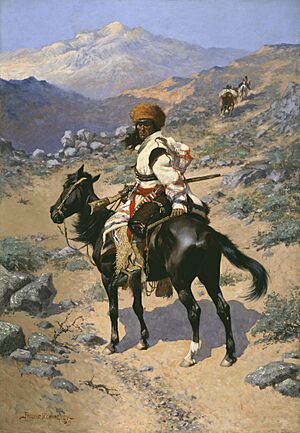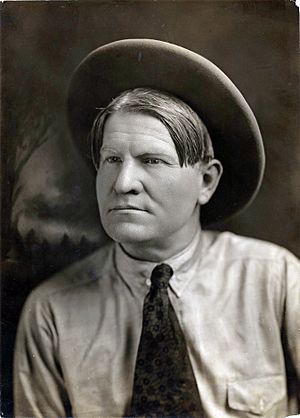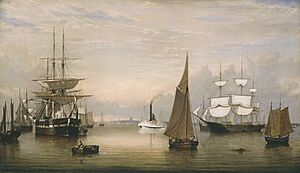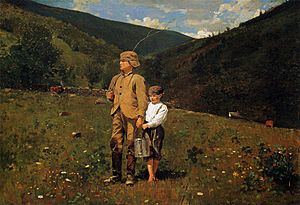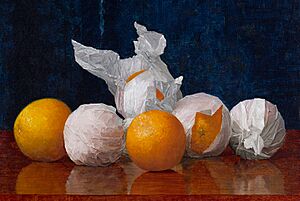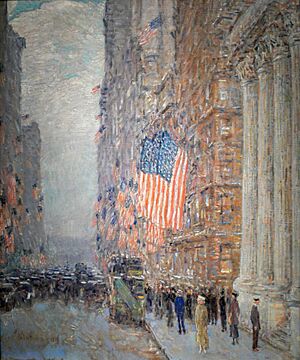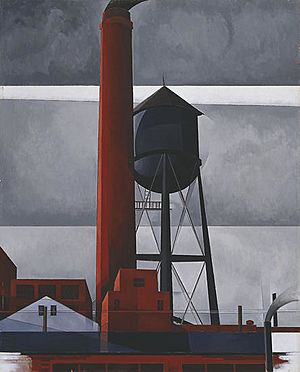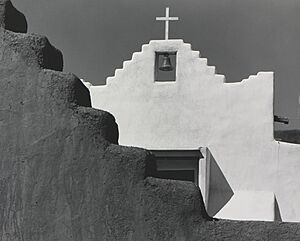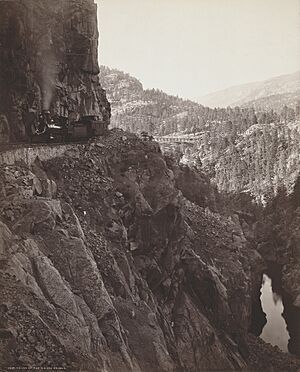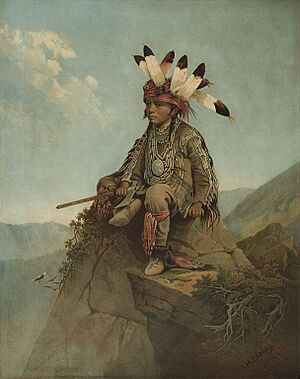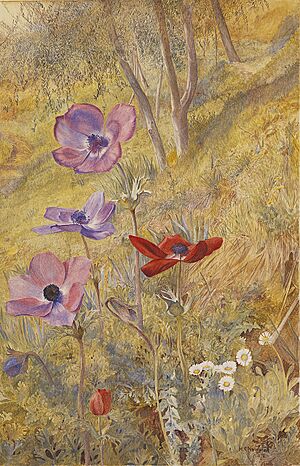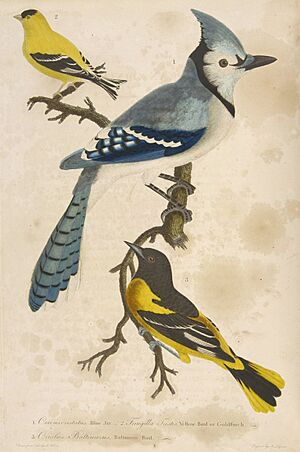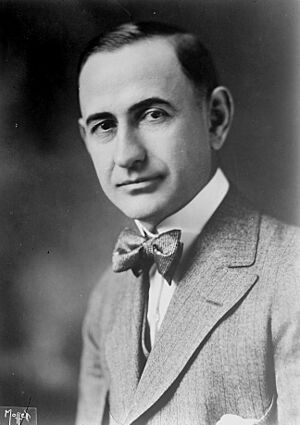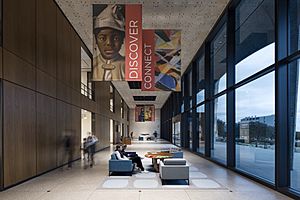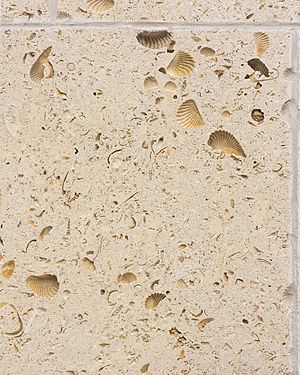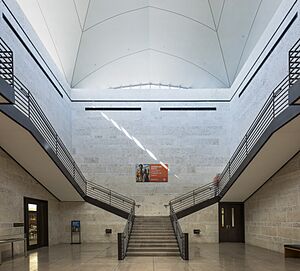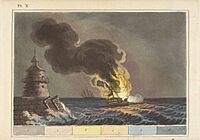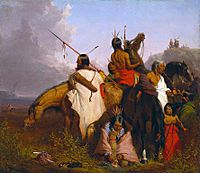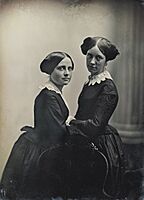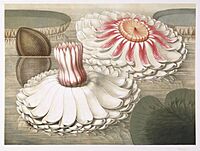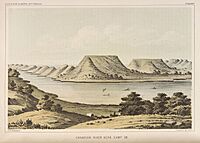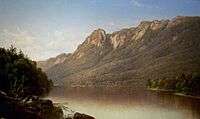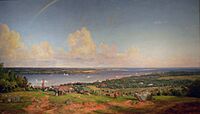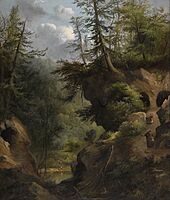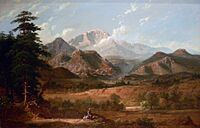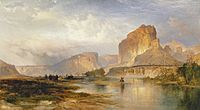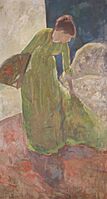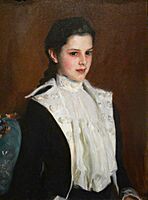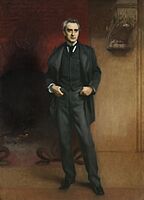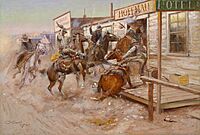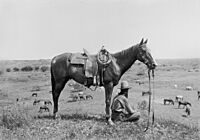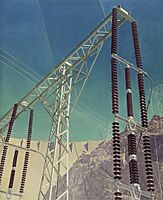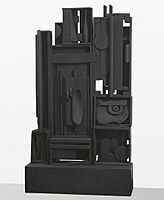Amon Carter Museum of American Art facts for kids
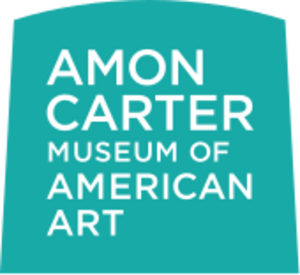 |
|
 |
|
| Established | January 1961 |
|---|---|
| Location | 3501 Camp Bowie Boulevard Fort Worth, Texas 76107-2695 (United States) |
| Architect | Philip Johnson |
The Amon Carter Museum of American Art (also called the Carter) is a cool art museum in Fort Worth, Texas. It's in the city's cultural area. The museum has a huge collection of paintings, photos, sculptures, and drawings. These artworks are by important artists from the United States. Most of the art is from the 1800s and early 1900s.
The museum started with art showing the Old West. This included famous works by Frederic Remington and Charles M. Russell. The collection also has many photos and prints from the past and today. You can see a lot of the art online on the museum's website. The best part? It's completely free to visit, even for special exhibits!
The Amon Carter Museum opened in 1961. It was first called the Amon Carter Museum of Western Art. The first collection had over 300 artworks by Frederic Remington and Charles M. Russell. These were collected by Amon G. Carter Sr.. He was a newspaper publisher and a generous person from Fort Worth. He spent the last ten years of his life planning for the museum.
Contents
Amazing Art Collections
Western Art by Frederic Remington and Charles M. Russell
The Carter museum has over 400 artworks by Frederic Remington (1861–1909) and Charles M. Russell (1864–1926). This is the main part of their Old West art collection. It includes drawings, letters with pictures, prints, oil paintings, sculptures, and watercolors. Amon G. Carter Sr. bought many of these works himself, starting in 1935. The museum has added even more of their best pieces over the years.
Remington and Russell were very famous for showing life in the American West. Remington worked from his New York studio. He created exciting pictures of the Old West. These pictures helped people in the East imagine what the frontier was like. Charles Russell lived in Montana. He dressed like a cowboy and was known for his stories. He became the image of a "Cowboy Artist."
Both artists made their drawings, paintings, and sculptures feel very real. They showed action and details from their own experiences. Russell worked as a cowboy for over ten years before becoming an artist. Remington traveled through the West as an illustrator. These experiences helped them create amazing art about the Old West.
Here are some famous artworks by Remington and Russell at the museum:
- Frederic Remington, A Dash for the Timber (1889): This painting made Remington a serious artist.
- Frederic Remington, The Broncho Buster (1895): This was Remington's first bronze sculpture. It started his career as a sculptor.
- Frederic Remington, The Fall of the Cowboy (1895): This artwork shows the end of the legendary cowboy era.
- Charles M. Russell, Medicine Man (1908): A detailed picture of a Blackfeet shaman. It shows Russell's respect for Native American culture.
- Charles M. Russell, Meat for Wild Men (1924): A bronze sculpture showing hunters chasing buffalo.
Art of Explorers and Native American Life
The Carter museum also has many maps and artworks by artists who explored North America. These artists traveled in the 1800s and 1900s. Some worked on their own. Others joined expeditions sent by the U.S. government. They drew and painted the land, animals, plants, and different Native American cultures. The museum wanted to collect these drawings, paintings, and prints from the very beginning.
Some of these artists include John James Audubon, Karl Bodmer, George Catlin, and Thomas Moran. Their art helps us see what America looked like long ago.
Beautiful Landscapes and Coastal Scenes
The museum has many paintings from the Hudson River School. This was a very important art movement in the 1800s. It focused on painting beautiful American landscapes. The collection includes major paintings by Thomas Cole and Frederic Edwin Church. These artists are key to the Hudson River School.
Other paintings show the influence of a style called Luminism. These artworks by artists like Sanford Robinson Gifford and Fitz Henry Lane often have a soft, glowing light. One famous painting is Thunder Storm on Narragansett Bay (1868) by Martin Johnson Heade. Many people think it's his best work.
Artists like Albert Bierstadt and Thomas Moran also painted grand landscapes of the American West. Bierstadt's Sunrise, Yosemite Valley is a huge painting from 1870. Moran's Cliffs of Green River (1874) shows the famous Yellowstone region.
People, Portraits, and Everyday Life
The museum has many paintings of people, portraits, and scenes from everyday life. These show an important part of American art history. Swimming (1885) by Thomas Eakins is one of the most famous realistic paintings in American art. It shows Eakins' amazing painting skills.
Crossing the Pasture (1871–72) by Winslow Homer is another great example. It shows a charming scene of country life in New York. Indian Group (1845) by Charles Deas explores the look of Native Americans and their traveling life.
The museum also has a historical painting by William T. Ranney, Marion Crossing the Pedee (1850). It shows his skill in painting people. Famous portrait artist John Singer Sargent has two formal portraits in the collection.
Still-Life Paintings and Sculptures
The Carter museum has many "fool the eye" paintings, called trompe-l'œil. These paintings make you think the objects are real. Ease (1887) by William M. Harnett is a great example. It shows how good he was at creating illusions. Other artists like John F. Peto also have amazing trompe-l'œil works here.
The museum also has classic still-life paintings. These show fruits or flowers. Peaches and Grapes in a Chinese Export Basket (1813) by Raphaelle Peale is one example. He was America's first recognized still-life painter.
The museum's sculpture collection helps us understand the bronze sculptures by Remington and Russell. It also shows the importance of sculpture in American art history. The Choosing of the Arrow (1849) by Henry Kirke Brown was one of the first bronzes made in America. Other sculptures include works by John Quincy Adams Ward and Hiram Powers.
Later sculptures by artists like Frederick William MacMonnies and Augustus Saint-Gaudens are also in the collection. These were made in the late 1800s. The museum also has sculptures by artists who focused on the Old West, like Solon Borglum.
American Impressionist and Modern Art
The Carter collection has several examples of American Impressionism. This art style uses light and color to capture a moment. Idle Hours (about 1894) by William Merritt Chase is a key painting here. Flags on the Waldorf (1916) by Childe Hassam is a famous New York scene. Other artists like Mary Cassatt are also featured.
The museum also has works by important modern artists from the early 1900s. These artists were often supported by photographer Alfred Stieglitz. They include Charles Demuth, Arthur Dove, Marsden Hartley, John Marin, and Georgia O'Keeffe. Chimney and Water Tower (1931) by Charles Demuth is a striking painting of a factory.
The museum also has paintings by Stuart Davis, including an early self-portrait. Other modern artists like Josef Albers and Charles Sheeler are also part of the collection.
Photography Collection
The Amon Carter Museum is one of the best places in the country for historical and fine art photographs. It has over 350,000 photos! These photos show the complete history of photography in America. They range from very old types of photos called daguerreotypes to modern digital images. The collection shows how photography has documented American culture and become an important art form.
The museum has special collections from photographers like Carlotta Corpron, Nell Dorr, Laura Gilpin, Eliot Porter, Erwin E. Smith, and Karl Struss. You can find information about these collections online.
The collection includes early photos of Americans at war. There are 55 daguerreotypes from the Mexican–American War (1847–1848). It also has famous books of photos from the Civil War. A highlight is a group of over 1,400 portraits of Native Americans from the 1800s and early 1900s. There's also a full set of Edward Curtis's The North American Indian.
The museum has many landscape photos from the 1800s. These include images by William Henry Jackson and Carleton Watkins. Later landscape photos by Ansel Adams and others are also here.
Important fine art photos by Alfred Stieglitz are a big part of the collection. He led a movement called Photo-Secession. The museum also has many documentary photos from the 1900s. These include works by Berenice Abbott and photos from the Standard Oil of New Jersey Collection.
Recently, the museum has been collecting photos by modern artists. These include Dawoud Bey, Sharon Core, and Alex Prager.
Works on Paper
Works on paper include drawings, prints, and watercolors. They tell a lot about America's history and art. The Carter started collecting these in 1967. Today, it has thousands of items by famous artists from the 1800s to today.
Many prints came from early surveys of the American West. Artists went with these expeditions and drew what they saw. These prints show unique views of the western landscape, Native American life, and old Spanish culture.
The collection also has a copy of the famous Hudson River Portfolio (1821–25). It includes original copper plate etchings by Karl Bodmer and a complete set of prints from George Catlin's North American Indian Portfolio. Also, there are bird prints from John James Audubon's famous book The Birds of America.
Important American artists like Winslow Homer, George Inness, and John Singer Sargent have high-quality drawings and paintings in this collection.
The museum also has a master set of over 200 lithographs by George Wesley Bellows. Other leading printmakers like Martin Lewis are also represented. Early watercolors by Edward Hopper and Jacob Lawrence are also here.
The Carter collection has almost 2,500 fine art lithographs from the Tamarind Institute. It also has a collection of drawings and prints by Texas artist Bror Alexander Utter.
Library and Archives
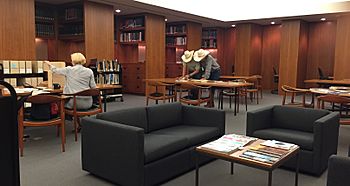
Amon Carter Museum of American Art Library Reading Room
|
The Carter library is a huge art library with 150,000 items. Museum experts, researchers, and the public can use it. It has 50,000 books, plus old newspapers, magazines, and other materials. You can't check out books, but you can study them there. The library focuses on American art, photography, and culture from early times to today.
The library has many old newspapers and books on microfilm. It also has over 50,000 microfiches of art catalogs and other items. The Amon Carter Museum is connected to the Archives of American Art. This means the library offers access to millions of documents about American artists, galleries, and collectors.
The library's "Vertical File" has lots of information on artists, museums, and art groups. It includes files on about 9,000 artists, photographers, and collectors. These files have newspaper clippings, small exhibit catalogs, and more.
The Carter library also has rare illustrated books. These books are important for their text and for their original prints. One example is American Ornithology (1809–14), the first bird book published in the U.S. Another is The Aboriginal Port-folio (1835–36), the first color plate book about Native Americans.
The museum archives hold private papers and records from artists and photographers. These are often linked to the museum's art collection. They include personal archives of photographers like Laura Gilpin and Eliot Porter. The archives also have business records from the Roman Bronze Works, a famous bronze art foundry.
In 1996, the Carter library teamed up with other museums in Fort Worth. They created the Cultural District Library Consortium (CDLC). This group shares resources online. In 1998, they launched an online catalog. Now, you can search the collections of several art museum libraries all at once.
Museum History
How the Museum Started
The idea for a free museum of western art came from Amon G. Carter Sr. (1879–1955). He was the publisher of the Fort Worth Star-Telegram newspaper. In 1945, Amon and Nenetta Burton Carter created the Amon G. Carter Foundation. They put a lot of their money into it to support good causes in the city. Amon Carter had already been collecting art by Frederic Remington and Charles M. Russell for ten years.
In 1950, Carter told the City of Fort Worth he wanted to build a museum and give it to the city. After he passed away in 1955, his will made sure the foundation would create the museum. It was meant to hold his art and "help the cultural spirit in Fort Worth." It also aimed to "inspire young people."
Amon Carter's daughter, Ruth Carter Stevenson, met architect Philip C. Johnson (1906–2005). She asked him to design the new museum. In 1959, the City of Fort Worth and the Amon G. Carter Foundation made a deal. The city provided the rest of the land needed. Construction began in 1960. The Amon Carter Museum of Western Art opened on January 21, 1961.
How the Museum Grew
Mitchell A. Wilder (1913–1979) became the museum's first director in 1961. He and the museum's board decided the museum should collect many types of American art. This led to the collection growing to include art from the 1800s and 1900s. Wilder also started publishing books about art and organizing important exhibits. In 1966, he brought the paintings of Georgia O'Keeffe (1887–1986) back into the national spotlight.
In 1967, an exhibit called American Art–20th Century brought over 100 modern paintings to Fort Worth. The museum bought Blips and Ifs (1963–64) by Stuart Davis from this show. This showed that the museum was collecting a wider range of art. Because the collection grew so much, the museum had two building expansions while Wilder was director. A big addition in 1977 doubled the museum's size.
Mitchell Wilder passed away in 1979. Four other directors have led the museum since then. They all worked closely with Amon Carter's daughter, Ruth Carter Stevenson (1923–2013). She knew her father's vision for the museum very well. Her high standards helped guide the museum's growth.
Jan Keene Muhlert (1980–95) led a big effort to buy new artworks. These included pieces by William Merritt Chase, Thomas Cole, and Thomas Eakins. The museum bought Eakins' masterpiece Swimming in 1990. This required raising ten million dollars! Rick Stewart (1995–2005) was an expert on Remington and Russell. He added major works by Stuart Davis and John Singer Sargent. He also oversaw a big renovation. The museum closed for two years to tear down old additions and build a much larger facility. It reopened in 2001.
Ron Tyler (2006–11) returned to the Carter as director. He had worked there earlier in his career. During his time, the museum showed major exhibits of art by Alfred Jacob Miller and William Ranney. They also added paintings by George de Forest Brush and Charles Sheeler. A complete 20-volume set of Edward Sheriff Curtis' The North American Indian was also added. Andrew J. Walker has led the Carter since 2011. He has brought major exhibits by George Caleb Bingham and Will Barnet. He also added works by Robert Seldon Duncanson and John Singer Sargent. He started projects to make more of the museum's past exhibits available online.
In 1977, the museum changed its name to the Amon Carter Museum. In 2011, for its 50th anniversary, it became the Amon Carter Museum of American Art.
The Museum Building
Original Building Design
The famous architect Philip C. Johnson (1906–2005) worked with the Amon Carter Museum for forty years. He designed the first building and two big expansions. In 1958, the Amon G. Carter Foundation asked Johnson to design a museum. It needed to show the western art collection and honor the founder. Johnson loved the museum's location on a hill. It had an amazing view of downtown Fort Worth. He placed the building high up to make the most of this view.
Johnson designed a two-story entrance with five arches. These arches faced east towards the city. The arches and their columns were covered in creamy Texas shellstone. The rest of the building was also covered in this stone. The front wall had big glass windows. Johnson said the design was inspired by old European buildings. The main entrance led into a two-story hall. It had the same shellstone, wood walls, and a floor of pink and gray granite. Beyond the hall were five small art galleries. Upstairs, there were five more galleries with balconies overlooking the main hall. These were used for the library and offices. Outside, Johnson designed wide steps and terraces leading down to a grassy plaza.
The museum opened on January 21, 1961. Critics really liked Philip Johnson's design. One magazine called it "an exceedingly handsome building." Another writer called it "Mr. Johnson's jewel box."
Building Expansions
1964 and 1977 Expansions
The museum quickly needed more space because it kept collecting more art. In 1964, a new section was added to the west side of the building. This gave more room for offices, a bookstore, a library, and art storage.
In 1977, the museum opened another big addition designed by Philip Johnson. This addition more than doubled the museum's original size. It added an office wing, an auditorium, more storage, and a larger library. It also created two indoor grassy courtyards.
1998–2001 Expansion
In 1998, the museum announced plans for another expansion. Philip Johnson designed this one too. He decided to remove the 1964 and 1977 additions. Then, he would build a much larger structure behind the original 1961 building. This was one of Johnson's last projects. The museum closed in August 1999 for the work. The 1961 building was updated, and the new addition was built.
The current museum building reopened on October 21, 2001. This expansion added 50,000 square feet of space. It is covered in dark granite, so it looks different from the light-colored original building. The most striking part is a central atrium, called the Lantern. It rises 55 feet high with a curved roof and side windows. The inside walls of the atrium are covered in the same shellstone as the original building. A double staircase leads from the atrium to the second-floor galleries. Here, you can see art from the museum's main collection and special exhibits. Most of the galleries in the 1961 building are now used for rotating exhibits of Remington and Russell's art.
The 2001 expansion also added a 160-seat auditorium. It has technology for distance learning. There are also special storage rooms for photos and art, and a research library.
2019 Renovation
In the summer of 2019, the museum closed for a renovation of the building and galleries. The changes mostly focused on the inside of the museum. The museum changed how it displayed its collection. Instead of showing art in time order, it now groups art by themes. They added movable walls to create more display space. The old carpet in the galleries was replaced with wooden floors. New LED lights and skylights were installed to bring in more natural light. An automatic shading system was added to allow art to be displayed in the lobby.
The 2019 renovations received good reviews from local newspapers. One critic said the new galleries created "an atmosphere for exploration." Another noted that the changes were "a big improvement."
The museum also updated its cold storage vaults for photographs. This helps keep the growing collection safe. A new study center was created in the library. It is dedicated to the artwork of Fort Worth brothers, Stuart W. and Scott G. Gentling. This center looks like Philip Johnson's original design, with wood walls and mid-century furniture.
More American Art from the Collection
See also
 In Spanish: Museo Amon Carter para niños
In Spanish: Museo Amon Carter para niños
- American Art Collaborative
- List of museums in North Texas


